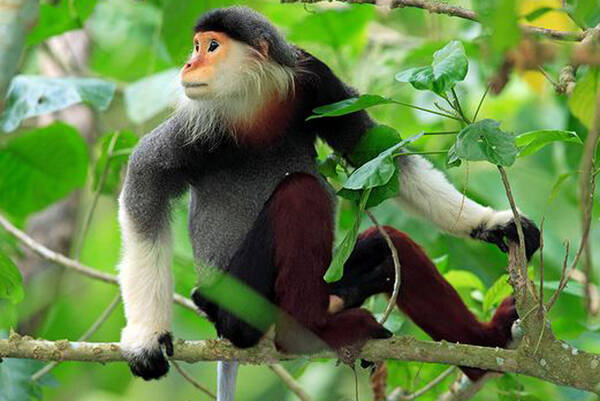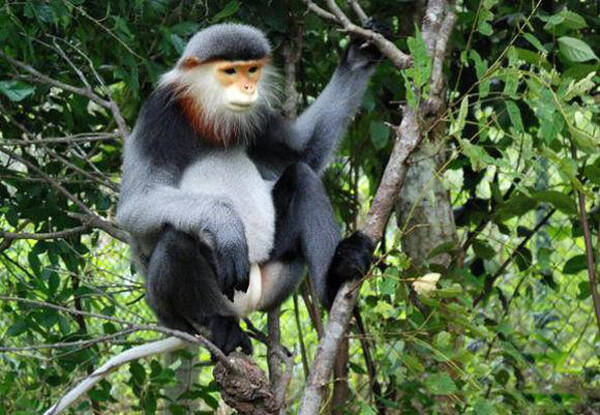Pygathrix
IUCN
LCBasic Information
Scientific classification
- name:Pygathrix
- Scientific Name:Pygathrix,Douc Langur,Gray-legged white-shanked langur, red-legged white-shanked langur, black-legged white-shanked langur
- Outline:Primates
- Family:Cercopithecidae W.Langur
Vital signs
- length:55-60cm
- Weight:8.2-12.6kg
- lifetime:No verification information
Feature
It is named because of the triangular white rump spot on the male's rump.
Distribution and Habitat
Distributed in Laos, Vietnam, Cambodia and other Southeast Asian countries. In China, it was once only distributed in Hainan Island.
It mainly inhabits tropical rainforests, monsoon forests and South Asian tropical monsoon evergreen broad-leaved forests on both sides of rivers and in low mountain valleys. The altitude of its habitat is about 2,000 meters.
Appearance
The male white-shanked langur is slightly larger than the female. The male weighs 10.9-12.6 kg, the head and body are 55-60 cm long, and the tail is 60-74 cm long; the female weighs 8.2-8.9 kg, the head and body are about 60 cm long, and the tail is about 60 cm long. The front of the head, shoulders, chest, elbows and the inside of the thighs, hands and feet are all black. The back of the body from the neck to the buttocks, the sides of the body and the lower limbs are iron red. The outer side of the forearm is yellowish white. There is a wide ochre-brown collar on the neck, and the throat, buttocks, perianal tail base and lower abdomen are white.
There are 3 species in total. The face of the red-legged white-shanked langur is orange-yellow, the back hair is gray and mottled, the lower part of the legs is chestnut brown, and the wrists are white. The face and lower part of the legs of the black-legged white-shanked langur are black, like wearing black socks, the forearms are gray, t
Details
Douc Langur (scientific name: Pygathrix), also known as Douc Langur, has three species: gray-legged white-shanked langur, red-legged white-shanked langur, and black-legged white-shanked langur. It is one of the most colorful primates.

The white-shanked leaf monkey is a diurnal monkey that lives in trees and often moves in the canopy of the forest, almost never going to the ground. They are good at jumping and their movements are graceful. When jumping, their forearms extend over their heads and their hind legs land first, and they can reach up to 6 meters in one leap. The white-shanked leaf monkey lives in groups, both small and large. Small groups are usually 4-5 or 8-10, including 1-2 adult males, several adult females and several cubs. It is a very social primate. The common responsibility of females in the family group is to help sub-adults integrate into the family and play and train anytime and anywhere. Social connections in these leaf monkey groups are very important, and they communicate through various sounds and visual signals, as well as tactile communication in the form of social grooming. Most groups are multi-male and multi-female, with more females than males, and there is a significant dominance hierarchy, with all males in a dominant position. It is common to see females grooming males in the group. This behavior plays a very important role in connecting the feelings between individuals and maintaining the relationship between group members.
The food of white-shanked langurs is mainly fresh leaves and tender shoots, and they also eat various wild fruits. The difference is that they rarely eat insects and other animal foods, and rarely go to the waterside to drink water. This may be because they can absorb most of the water they need from the tender leaves and young shoots of trees, and they can also get some water from the dew on the branches and leaves in the early morning.
White-shanked langurs mature late and have a low reproduction rate. Males mature at the age of 5, and females at the age of 4. They only give birth to one baby each time. The estrus cycle of females is about 28-30 days. During estrus, the inner side of the thigh turns from white to red, and even lasts throughout the pregnancy. The gestation period is about 165 days, and most of them give birth between February and June. Even during pregnancy, males are still allowed to mate, and mating behavior has even been seen on the day of birth. The newborn cub has a white body, black face, white spots near the eyes, and red hair crown, neck and back. The cub attracts the attention of all the females in the group, who compete to hug and groom it.

The destruction of natural habitats is the main threat to white-naped leaf monkeys. A large part of central and southern Vietnam has suffered extensive wartime destruction, and postwar human population explosions and extensive deforestation for coffee, rubber, and cashew plantations have reduced its natural habitat. Most of the forests in the lowland elevations have been cleared, and few forests are undisturbed. The migration of about 3 million people from northern Vietnam to the central highlands is likely to exacerbate the rate of habitat loss across the species' range in Vietnam. In Laos and Vietnam, general infrastructure development, and construction of the Ho Chi Minh Highway in particular, poses a major threat to the species' habitat. Hunting is also a major threat to the white-shanked langur, most commonly for subsistence use in traditional "medicine" and sometimes for the international pet trade, particularly from Laos to Vietnam and Thailand.
The killing of white-shanked langurs is legal in Vietnam and Laos, but not mandatory (1999). Several protected areas have also been established in these countries, including Nakai Nam Theun National Biodiversity Reserve, Hin Namno National Biodiversity Reserve, Phou Son Vientiane National Biodiversity Reserve, Xe Sap National Biodiversity Reserve, Xe Sap National Biodiversity Reserve (Laos), Ma Bach National Park, Phong Nha-Ke Bang National Park, Phu Mat National Park (Vietnam). A website for the species has also been established in the Khe Sanh Nature Reserve in Vietnam (2008). In the national parks of Vietnam, there is an endangered primate rescue center with an ongoing captive breeding program.
All are listed in the 2008 IUCN Red List of Threatened Species ver 3.1.
Endangered (EN) - 2 species, Critically Endangered (CR) - 1 species.
Listed in the CITES I level protected animals of the Washington Convention.
Listed in Appendix I, Appendix II and Appendix III of the Convention on International Trade in Endangered Species of Wild Fauna and Flora (CITES) 2019 Edition.
Protect wild animals and eliminate game.
Maintaining ecological balance is everyone's responsibility!








